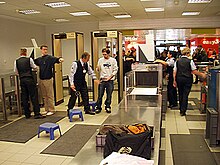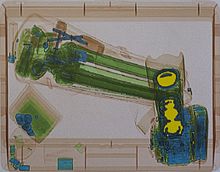Airport security


Under airport security covers all measures that the prevention of crime , particularly terrorist attacks on the airport , ie on the ground, are used. With large numbers of people in a relatively small space, airports are a potential target for terrorism . Most major airports have their own security guards supported by police officers . In some countries paramilitary forces or soldiers protect airports from threats.
Airport security is a sub-area of aviation security that is generally about preventing terrorist or other criminal influences on the security of civil aviation.
This is to be distinguished from the terms flight safety , i.e. the prevention of air accidents in the broadest sense, and air traffic control , which is the regulation of traffic processes in the airspace.
To ensure safety in civil aviation , the International Civil Aviation Organization (ICAO) prescribes the use of safety management systems (SMS) for various aviation organizations such as airport operators . The basic idea of the SMS is to understand safety as a management task, i. H. to proactively identify latent dangers in order to prevent them at an early stage (see also the ACRP reports “Safety Management Systems for Airports”).
Legal basis
After the terrorist attacks on September 11, 2001 , Regulation (EC) 2320/2002 was introduced. This should make it impossible for terrorists to break into an aircraft through new security measures. For example, airports are divided into certain security areas, the access of which is strictly controlled. The controls of passengers and hand luggage have also been tightened and the minimum requirements for equipment have been precisely regulated. In addition, member states and airports are obliged to create their own security programs.
In Germany, aviation security measures are regulated by federal law. A special Aviation Security Act (LuftSiG) has been in force since January 15, 2005 . The main preventive tasks that affect airport security can be summarized as follows:
- Section 5 of the Aviation Security Act defines the tasks and competencies of the aviation authorities, including the search of passengers and baggage.
- Section 7 of the Aviation Security Act regulates the background check procedure, which every German citizen, but not citizens of other countries, who wants to actively participate in air traffic and also everyone who wants to move around security-relevant airport areas, must undergo. The background check must be repeated regularly at the applicant's expense. However, in the opinion of the EU Commission, this regulation contradicts European law , the FRG has been given a deadline to withdraw this regulation before charges are brought before the European Court of Justice.
- Section 8 of the Aviation Security Act regulates the airport operators' own security obligations (colloquial: "airport security")
Historical development
When the number of aircraft hijackings increased internationally at the end of the 1960s , the Federal Government urged preventive measures. At that time, however, there was no legal basis. The Landshut abduction in 1977 raised awareness of aviation security and a few years later led to the Civil Aviation Act. The law said that the control of passengers and baggage must be carried out by the countries that bear most of the costs. The main components of the controls must not be outsourced to private companies in order to guarantee high standards and exclude price competition. Since 1980, all passengers and all hand luggage have been screened or scanned. After the Lockerbie attack in 1988, the proportion of checked baggage was continuously increased and from the end of 2002 all checked baggage will be checked without exception. In 1990 the federal government introduced a security fee to cover part of the expenditure. The outsourcing of security controls has been permitted since 1992, but private security personnel could not be employed until 1995 due to strict requirements. The federal government still has a strong influence and makes high demands. Since the attempted terrorist attack on the approach to Landing in Detroit in 2009, security control has come under greater media focus. The attacker Umar Farouk was able to go unnoticed through the metal detector at Schiphol Airport in Amsterdam with his plastic explosives. As a result, Amsterdam Airport introduced the first body scanners.
Implementation of the legal requirements
- Passenger and baggage checks
On many flights, the identity of the passengers is verified through passport controls before they are allowed to board. Travelers and flight personnel are examined in security gates with metal detectors for metallic objects and scanned if necessary. The luggage and other transport goods are x-rayed to prevent weapons or explosives from being brought on board an aircraft. Hand luggage is also checked; All types of weapons and their imitations, other dangerous objects and large quantities of gels and liquids are not permitted. Unattended baggage will be removed and examined by security personnel. Protection against manipulation in the storage area must be ensured. The luggage is only transported if the associated passenger is on board the aircraft.
- Background checks
Employees at airports, airfields and airlines, flight students and members of aviation clubs, with the exception of pilots who only have a microlight or glider license, must be checked annually by the aviation security authorities. Private security companies and agencies for temporary employment are certified after a detailed background check and bound by long-term contracts and minimum wages. The largest agencies in the field of temporary employment at airports are organized internationally through an association. Personnel may only be hired after the Federal Aviation Office has checked their reliability through inquiries from various bodies (e.g. the police enforcement authority).
Persons whose reliability has not been confirmed by an aviation security authority may only enter areas of the airport that are not generally accessible if they have valid access authorization (valid flight ticket) and the controls (search of the person and hand luggage) have been completed. They are not allowed to work in the airport, on the airfield or on an airplane. Aircraft crews (pilots and flight attendants), ground and security personnel, cleaning staff and goods suppliers, transporters, employees at construction companies who have to drive into security-relevant areas of the airport are subject to a reliability check (Section 7) and can practically not carry out their work without a positive background check. However, pilots with a foreign license are not affected.
- Guarding the entire airport area and controlled access for delivery traffic and personnel.
Airport buildings, aircraft and all important systems are protected by measures such as alarm systems, video surveillance, fencing, lighting and motion detectors. Patrols take place regularly to ensure security at the airport. Employees' access to security-sensitive areas is controlled using ID cards, PIN entry or biometric procedures.
The Transportation Security Administration (TSA) of the Department of Homeland Security is now responsible for airport security in the USA . Before September 11, 2001, security was taken care of by private security companies and, at the insistence of airport operators and airlines , the cheapest security companies were often preferred. Not infrequently the lowest paid airport employee was a security guard .
- Freight and mail
In Germany there are so-called regulated agents, i.e. freight forwarders and handling companies who are certified by the Federal Aviation Office. For this, there must be security documentation for shipments, employee training and other measures to protect air transport security. There is also the regulation of known senders who have to submit a security declaration to the regulated agents. Your shipments are then treated as known cargo and the cargo items are only randomly checked at the airport. Similar regulations apply to mail carried by air as to freight. In addition, the route and flight time of the transporting machine are not mentioned for express shipments.
Profiling
So-called " Profiling " is used to search for people with suspicious behavior.
literature
- Geminn, Christian: Legally compatible use of safety measures in public transport , Wiesbaden 2014, ISBN 9783658053529
Web links
- Security problems at the airport ( memento from July 19, 2015 in the Internet Archive ) - plus minus from July 15, 2015
Footnotes
- ↑ http://www2.icao.int/en/ism/Guidance%20Materials/DOC_9859_FULL_EN.pdf ( Memento of March 24, 2012 in the Internet Archive ) , Safety Management Manual (SMM), ICAO Doc 9859, ISBN 978-92- 9231-295-4 , 2009
- ↑ [1] (PDF; 1.7 MB), ACRP Report 1: "Safety Management Systems for Airports", Volume 1: Overview, Transportation Research Board, Washington, DC, 2007
- ↑ [2] ( page no longer available , search in web archives ) ACRP REPORT 1: “Safety Management Systems for Airports”, Volume 2: Guidebook, Transportation Research Board, Washington, DC, 2009
- ↑ § 8 LuftSiG - single standard. Retrieved June 30, 2017 .
- ↑ ? Airport Lifehack - ingenious tips and tricks for departure. In: World Tour - The Travel Podcast. Retrieved on March 29, 2019 (German).
- ↑ Information on passenger and baggage controls ( Memento from December 3, 2013 in the Internet Archive ). Website of the German Federal Aviation Office. Retrieved August 17, 2010.
- ↑ Airport Promotion Agencies ( page no longer available , search in web archives ) Info: The link was automatically marked as defective. Please check the link according to the instructions and then remove this notice. . Website of the agency association APA for temporary employment at airports. Retrieved August 17, 2010.
- ↑ Background check . Website of the State Office for Building and Transport (LBV). Retrieved August 17, 2010.
